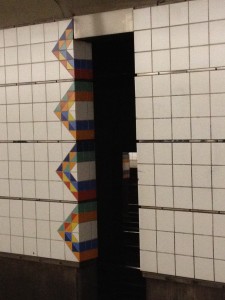Exploring Authentic Assessment
If you're an educator or are somehow otherwise plugged into education policy, you're familiar with the Common Core State Standards (CCSS). The standards have re-energized a national conversation around teaching and learning experiences that demand higher levels of thinking and real world application. Students in 45 states will be assessed against these standards starting with the 2014-2015 school year. In light of this, there is a flurry of activity in school buildings, at district offices and certainly at curriculum companies to create common core aligned assessments and other instructional material to better prepare students and teachers for the new challenges.

A few weeks ago, as I waited for the R train, I got to thinking about creating real world and authentic assessments. I wondered: _How can we ensure authenticity in a teaching and learning experience? What makes a learning experience authentic and to whom? What happens when students don’t have context for the content, can they still have a meaningful learning experience? (how?) Should everything begin from the familiar or the unfamiliar? How do educators reconcile authentic learning experiences with the need to deliver specific content and skills?_As I continued to wait, I looked around and noticed that there was a pattern on some of the pillars that divide the subway traffic lanes. This led me to some more questions: Are there tiles on the other side of those pillars? Are all the subway stops designed similarly? What materials are used? I wondered what this could look like if I continued along this line of inquiry and tried to create questions that could assess learning and thinking. I broke this up into ideas and questions for younger students versus older students.Here's what I pulled together:
Younger students
Potential avenues for conversation/ problems of practice/ “tasks”:
- Practice counting the total number of white tiles and ceramic color tiles
- Recreate the pattern that was represented with the ceramic tiles using the same or different color tiles, looking closely at what a pattern is and where evidence is of other patterns Related questions: what are patterns? What patterns have you seen at home, at school, on the subway or bus? What patterns aren't visual, but can still be observed?
- Practice multiplication e.g. if there are 5 more pillars like the one in the image, how many white tiles are needed? How many ceramic color tiles are needed? How do you know?
- Have a couple "sample" tiles and give students the chance to practice measurement
Connections to skills/content:
patterns, colors, placement using similar shapes, counting, measurement
Older students
Potential avenues for conversation/ problems of practice/ “tasks”:
- An early proof – state the given information, reasonable assumptions that can be made and explore the implications e.g. The tiles only cover three sides of the pillar
- How many triangular tiles needed for 60 pillars? Or 5 subway stops? (both uptown and downtown?)
- If the color tiles are placed on every other pillar and there are 60 pillars on an average at a subway stop, how many of each tile is needed to complete the project?
- How many metal bands are necessary?
- If you were in the urban planning department at the MTA and your supervisor told you that you were going to create two new subway stations, and the large tiles cost $X and the smaller ceramic tiles cost $Y, what is the estimate of how much it would cost for tiles? What other considerations would need to be made? What happens if they gave you a bulk discount?
Connections to skills/content covered:
patterns, writing mathematical proofs - extrapolating based on given evidence and logical assumptions (in CCSS language “mathematical modeling”), multiplication, linear equationsWhen I finished, I was thrilled because starting with a genuine inquiry resulted in some good questions that had an equal chance of covering content and skills without having to map things backward from the standards. Instead, I can now take what I constructed and reference the standards, which could help me iterate again on this initial thinking or determine what else I need to cover in future lessons/conversations with students. I believe if we could refocus teaching and learning on the experiences and questions that teachers and students have, material can still get covered, but it can be responsive to the interests of the learners in the room. I think it’s also a way for teachers to stay engaged, versus having to deliver content that is prescribed or recommended to them.My hypothesis: If the emphasis in classrooms was working on thinking skills and finding meaningful ways to connect with students on content, that test prep is not necessary, because students can think their way through any situation. Is this true? I didn’t plan it this way, but this post happens to coincide with one of two weeks of NY State testing - an arduous process that freezes all normal activity at a school and wreaks havoc on the psyche of teachers and students, given the high stakes. I can’t help but wonder what state testing week would be like in a world where the emphasis was authentic assessment and not obsessive adherence to standards and standardized tests.Click here for a salient article describing some issues related to the testing industrial complex.